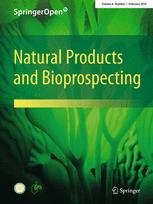|
|
Two New Steroidal Saponins from Ypsilandra thibetica
Collect
Yong-Ai Si, Huan Yan, Wei Ni, Zhen-Hua Liu, Ting-Xiang Lu, Chang-Xiang Cheng, Hai-Yang Liu
Natural Products and Bioprospecting. 2014, 4 (6): 315-318.
DOI: 10.1007/s13659-014-0043-1
Two new monosaccharide steroidal saponins, named ypsilandroside S(1) and ypsilandroside T(2), have been isolated from the whole plants of Ypsilandra thibetica. Their structures were elucidated as heloniogenin 3-O-β-D-apiofuranoside(1) and pregna 5, 16-dien-3β, 12α-diol-20-one-3-O-β-D-apiofuranoside(2) by spectroscopic techniques(1D and 2D NMR, MS). Compounds 1 and 2 were tested for their inhibitory effects on lipopolysaccharide-induced nitric oxide production in RAW 264.7 cells.
References |
Related Articles |
Metrics
|
|
|
Novel Inhibitory Effects of Glycyrrhizic Acid on the Accumulation of Advanced Glycation End Product and Its Receptor Expression
Collect
Hong Sheng Cheng, Joana Magdelene Xiao Fang Kong, Athena Xin Hui Ng, Weng Keong Chan, So Ha Ton, Khalid Abdul Kadir
Natural Products and Bioprospecting. 2014, 4 (6): 325-333.
DOI: 10.1007/s13659-014-0044-0
Beneficial effects of glycyrrhizic acid(GA), a bioactive extract of licorice root, in the prevention of metabolic syndrome have been consistently reported while advanced glycation end products(AGE) and receptor for advanced glycation end product(RAGE) are the leading factors in the development of diabetes mellitus. The aim of this study was to investigate the effects of GA on the AGE-RAGE axis using high-fat/high-sucrose(HF/HS) diet-induced metabolic syndrome rat models. Twenty four male Sprague-Dawley rats were randomly assigned into three groups for 4 weeks:(1) Group A, normal diet with standard rat chow;(2) Group B, HF/HS diet;(3) Group C, HF/HS diet and oral administration of 100 mg/kg GA per day. The results showed that HF/HS diet elevated the fasting blood glucose level and insulin resistance index which was prevented by GA supplementation. GA treatment significantly lowered the circulating AGE independent of its glucose-lowering effect. HF/HS diet also triggered RAGE upregulation in the abdominal muscles while GA administration downregulated RAGE expression in the abdominal muscles, aorta and subcutaneous adipose tissues. In conclusion, HF/HS diet could cause glucose intolerance, insulin resistance and upregulation of RAGE expression while GA ameliorated the metabolic dysregulation besides exhibiting inhibitory effects on the AGE-RAGE axis.
References |
Related Articles |
Metrics
|
|
|
Limonoid and Steroidal Saponin from Azadirachta indica
Collect
Lu Liu, Yun-Li Zhao, Gui-Guang Cheng, Ying-Ying Chen, Xu-Jie Qin, Chang-Wei Song, Xing-Wei Yang, Ya-Ping Liu, Xiao-Dong Luo
Natural Products and Bioprospecting. 2014, 4 (6): 335-340.
DOI: 10.1007/s13659-014-0042-2
A new limonoid, 17-(5-methoxy-2-oxofuran-3-yl)-28-deoxonimbolide(1), and a new C21 steroidal saponin, 2α, 4α-dihydroxy-pregn-5-en-16-one-3α-O-D-glucopyranoside(2), together with 11 known compounds were isolated from the methanol extract of the leaves of Azadirachta indica. The structures were elucidated by means of spectroscopic analysis and putative biosynthetic origins. All the compounds were evaluated for their antibacterial activities against six bacterial strains.
References |
Related Articles |
Metrics
|
|

